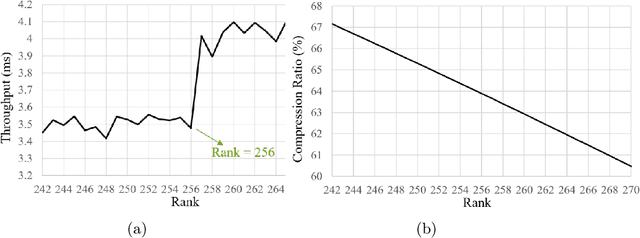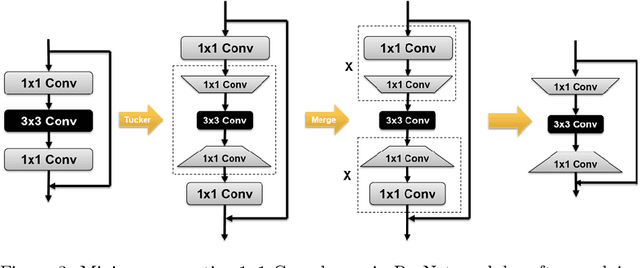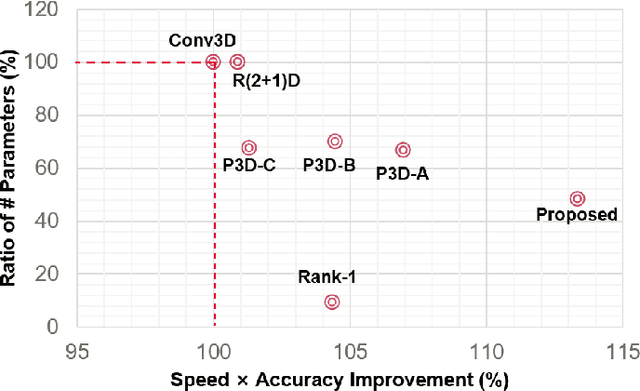Austin Wen
Accelerating the Low-Rank Decomposed Models
Jul 24, 2024



Abstract:Tensor decomposition is a mathematically supported technique for data compression. It consists of applying some kind of a Low Rank Decomposition technique on the tensors or matrices in order to reduce the redundancy of the data. However, it is not a popular technique for compressing the AI models duo to the high number of new layers added to the architecture after decomposition. Although the number of parameters could shrink significantly, it could result in the model be more than twice deeper which could add some latency to the training or inference. In this paper, we present a comprehensive study about how to modify low rank decomposition technique in AI models so that we could benefit from both high accuracy and low memory consumption as well as speeding up the training and inference
Is 3D Convolution with 5D Tensors Really Necessary for Video Analysis?
Jul 23, 2024



Abstract:In this paper, we present a comprehensive study and propose several novel techniques for implementing 3D convolutional blocks using 2D and/or 1D convolutions with only 4D and/or 3D tensors. Our motivation is that 3D convolutions with 5D tensors are computationally very expensive and they may not be supported by some of the edge devices used in real-time applications such as robots. The existing approaches mitigate this by splitting the 3D kernels into spatial and temporal domains, but they still use 3D convolutions with 5D tensors in their implementations. We resolve this issue by introducing some appropriate 4D/3D tensor reshaping as well as new combination techniques for spatial and temporal splits. The proposed implementation methods show significant improvement both in terms of efficiency and accuracy. The experimental results confirm that the proposed spatio-temporal processing structure outperforms the original model in terms of speed and accuracy using only 4D tensors with fewer parameters.
SkipViT: Speeding Up Vision Transformers with a Token-Level Skip Connection
Jan 27, 2024Abstract:Vision transformers are known to be more computationally and data-intensive than CNN models. These transformer models such as ViT, require all the input image tokens to learn the relationship among them. However, many of these tokens are not informative and may contain irrelevant information such as unrelated background or unimportant scenery. These tokens are overlooked by the multi-head self-attention (MHSA), resulting in many redundant and unnecessary computations in MHSA and the feed-forward network (FFN). In this work, we propose a method to optimize the amount of unnecessary interactions between unimportant tokens by separating and sending them through a different low-cost computational path. Our method does not add any parameters to the ViT model and aims to find the best trade-off between training throughput and achieving a 0% loss in the Top-1 accuracy of the final model. Our experimental results on training ViT-small from scratch show that SkipViT is capable of effectively dropping 55% of the tokens while gaining more than 13% training throughput and maintaining classification accuracy at the level of the baseline model on Huawei Ascend910A.
SwiftLearn: A Data-Efficient Training Method of Deep Learning Models using Importance Sampling
Nov 25, 2023


Abstract:In this paper, we present SwiftLearn, a data-efficient approach to accelerate training of deep learning models using a subset of data samples selected during the warm-up stages of training. This subset is selected based on an importance criteria measured over the entire dataset during warm-up stages, aiming to preserve the model performance with fewer examples during the rest of training. The importance measure we propose could be updated during training every once in a while, to make sure that all of the data samples have a chance to return to the training loop if they show a higher importance. The model architecture is unchanged but since the number of data samples controls the number of forward and backward passes during training, we can reduce the training time by reducing the number of training samples used in each epoch of training. Experimental results on a variety of CV and NLP models during both pretraining and finetuning show that the model performance could be preserved while achieving a significant speed-up during training. More specifically, BERT finetuning on GLUE benchmark shows that almost 90% of the data can be dropped achieving an end-to-end average speedup of 3.36x while keeping the average accuracy drop less than 0.92%.
GQKVA: Efficient Pre-training of Transformers by Grouping Queries, Keys, and Values
Nov 06, 2023Abstract:Massive transformer-based models face several challenges, including slow and computationally intensive pre-training and over-parametrization. This paper addresses these challenges by proposing a versatile method called GQKVA, which generalizes query, key, and value grouping techniques. GQKVA is designed to speed up transformer pre-training while reducing the model size. Our experiments with various GQKVA variants highlight a clear trade-off between performance and model size, allowing for customized choices based on resource and time limitations. Our findings also indicate that the conventional multi-head attention approach is not always the best choice, as there are lighter and faster alternatives available. We tested our method on ViT, which achieved an approximate 0.3% increase in accuracy while reducing the model size by about 4% in the task of image classification. Additionally, our most aggressive model reduction experiment resulted in a reduction of approximately 15% in model size, with only around a 1% drop in accuracy.
Speeding up Resnet Architecture with Layers Targeted Low Rank Decomposition
Sep 21, 2023Abstract:Compression of a neural network can help in speeding up both the training and the inference of the network. In this research, we study applying compression using low rank decomposition on network layers. Our research demonstrates that to acquire a speed up, the compression methodology should be aware of the underlying hardware as analysis should be done to choose which layers to compress. The advantage of our approach is demonstrated via a case study of compressing ResNet50 and training on full ImageNet-ILSVRC2012. We tested on two different hardware systems Nvidia V100 and Huawei Ascend910. With hardware targeted compression, results on Ascend910 showed 5.36% training speedup and 15.79% inference speed on Ascend310 with only 1% drop in accuracy compared to the original uncompressed model
 Add to Chrome
Add to Chrome Add to Firefox
Add to Firefox Add to Edge
Add to Edge